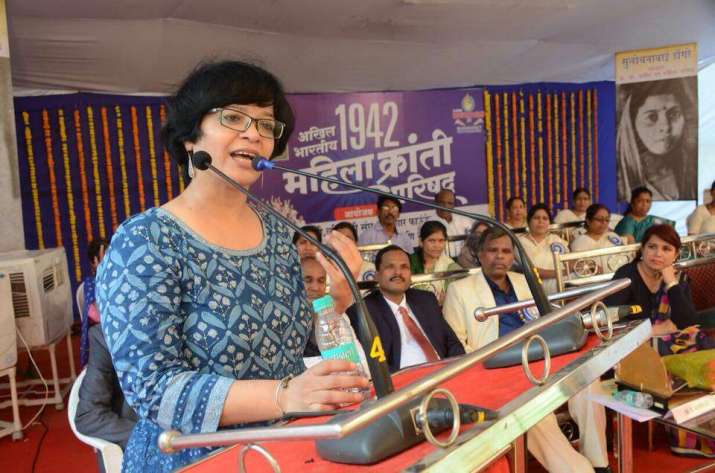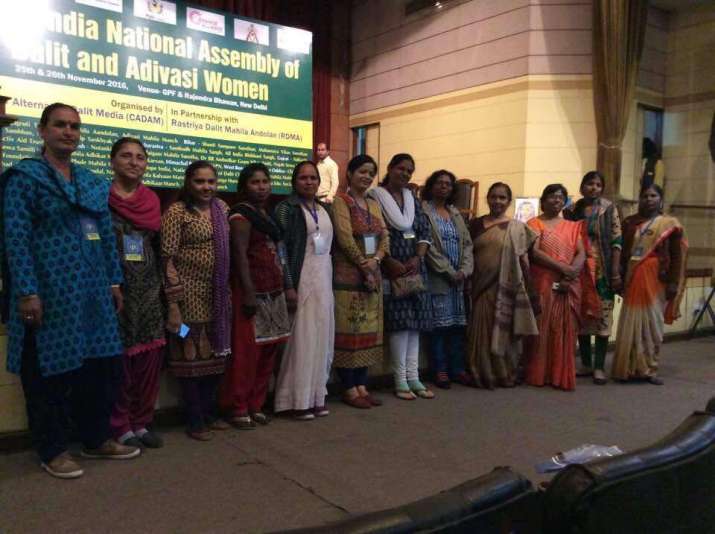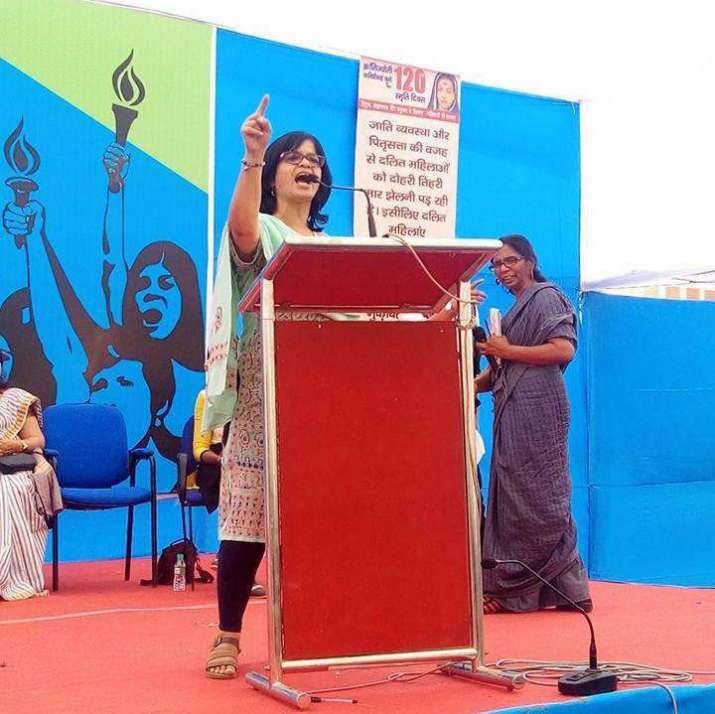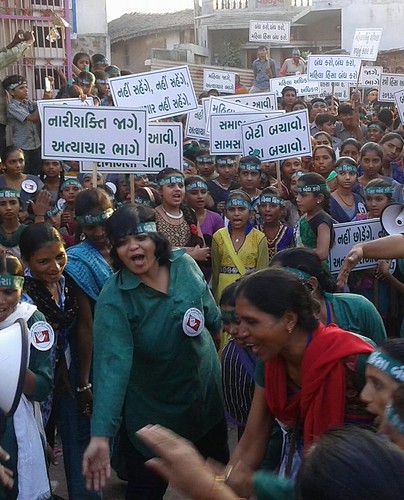FEATURES
A New Birth: Walking on the Path of Buddhism
 Buddhist and social activist Majula Pradeep. Image courtesy of author
Buddhist and social activist Majula Pradeep. Image courtesy of authorManjula Pradeep is a Buddhist convert and social activist in India. She was the first Dalit woman to join the Navsarjan Trust, one of the largest Dalit rights organizations addressing the issues of caste and gender based discrimination, and became its Executive Director in 2004. In this moving narrative, she relates her upbringing as a Hindu and as a member of one of India’s “untouchable” Dalit communities, and the experiences and and events that led her to embrace Buddhism and to fight for social equality and empowerment for India’s most disenfranchised people.
I recently turned 48. Time flies, but memories remain. Especially those that are very painful, formed by the experiences that shape us and make us grow into the person we are. Painful memories teach us lessons, but also give us realizations and experiences that mold our life. Here is my life story and some of the experiences that led me toward the Buddhist path.
I come from a Dalit family in the Indian state of Uttar Pradesh. My parents hail from a small village near the town of Aligarh, famous for its university and door locks. My father was the only sibling out of his entire family to attend university. After graduating with a BA, he worked as a geologist for the Survey of India, New Delhi. He later obtained an MA before working in the Oil and Natural Gas Commission (ONGC). My father married twice. His second wife gave birth to me and my two siblings, my older sister and younger brother. My mother was almost 17 years younger than my father and was just 17 when I was born.
In 1969, when I was in my mother’s womb, my father was transfered to Vadodara in Gujarat. It was a period of some of the deadliest communal violence between Hindus and Muslims during September–October 1969. According to official figures, 660 people were killed, 1,074 people were injured, and more than 48,000 lost their property. Unofficial reports put the death toll as high as 2,000.
I first came to understand the seriousness of the social issues between the Muslim and Hindu communities when I visited Surat to see the devastation of Muslim properties by Hindu fundamentalists in 1992, the year I joined Navsarjan—an activist organization fighting for Dalit rights. The communal riots took place on the 6 December, the anniversary of the death of Dr. B. R. Ambedkar. It was during these riots that the 16th century Babri Masjid (Mosque of Babur) in Ayodhya was demolished by Hindu Kar Sevaks (activists). My own identity as a Hindu had been troubling me since I first began to understand what it means to be a woman in a Hindu family.
I remember my first experience of gender discrimination when I reached puberty. I was told to not to get too close to our Hindu idols, not to visit temples, and to stay away from religious practices. I was, on one side, struggling with my Dalit identity and on the other with my gender identity. I had so many questions, but no answers. Nobody in my family or in my neighborhood talked about the life and work of Dr. Ambedkar, Jyotiba Phule, or Savitribai Phule. I never read books written by these eminent reformers, but I read newspapers since childhood and became very aware of the political aspects of my country, expecially the assassination of Indira Gandhi and the Sikh riots in 1984, when I was just 15 years old. It left a strong impression.
While doing my master’s degree in social work from 1990–92, I realized that even educational institutions did not teach Ambedkar’s philosophy. I could not find any of his writings in our library at the Faculty of Social Work. I was one of very few students from Dalit communities who were pursuing a degree in social work. The two-year course taught me a lot, especially the field placements.
My life changed completely when I joined Navsarjan, which is now one of the foremost Dalit rights NGOs in India. I came to understand the intricacies of the caste system and its implications for the country’s Dalit communities. Being a woman, I also realized the painful realities facing Dalit girls and womens, who were struggling just to exist among all these challenges. Being born into a Hindu family posed a fundamental challenge to me. I began asking myself: Why do I need to call myself a Hindu, when I and my community are considered untouchable and face discrimination? What is there to be proud of being a Hindu? While reading Dr. Ambedkar’s works on the caste system and its manifestations, I began to perceive the ugliness of the Hindu religion—especially in his book Riddles in Hinduism.
My life started changing dramatically as I began to reject the norms, traditions, and practices of the Hindu religion. This was difficult as my mother is a staunch Hindu, but my mind was telling me to try to understand society through the lens of Dr.Ambedkar, who also wrote Annihilation of Caste. I started reading about the life and work of Jyotiba Phule and Savitribai Phule. The majority of the Dalits with whom I was working in Gujarat, however, still identified as Hindus. Despite being discriminated against and being ostracized, they wanted to remain Hindus.
 Image courtsey of author
Image courtsey of authorWhile working on the issues of discrimination, atrocities, and violence committed against Dalits, Adivasis (a collective term for the indigenous people of mainland South Asia), and women across communities, I realized that most people follow Hindu practices and traditions without understanding their consequences. Rituals such as putting vermillion on the forehead during the yatras and foot marches are viewed as part of Dalit culture, rather than Hindu culture. I could also see that the majority of Dalits and Adivasis had internalized Hindu culture as a way of proving that they were part of mainstream society, but it also showed their insecurity and the need to survive in a volatile situation imposed by a caste system based on Hinduism. But this point, I hardly practiced Hinduism anymore. I rarely went to Hindu temples, never fasted, nor practiced rituals, which was shocking for my mother.
When I was organizing bonded- and agricultural workers, specifically women from Dalit and other poor communities, in 1995, I could see how these people lived in fear of their landlords, who forced them to undertake hard labour without proper wages. Although it was challenging, I began conducting training programs for them, which generated awareness and, as a result, they started demanding proper wages as per government regulations. I formed a labour union and a cooperative society for women, not only to demand fair pay, but also to teach the women and labourers skills that could liberate them from forced labour. This created tension with the landlords, who had strong affiliations with right-wing groups such as Vishwa Hindu Parishad. In June 1997, a rally was organized in Padra town that had a lot of impact in the area; wages were raised in almost 60 villages of the Padra block in Gujarat’s Vadodara Dstrict. But my own struggle was also becoming more intense.
I was challenged by men associated with right wing groups, and also by the administrative authorities. They wanted to uproot us and stop the work that we were doing with the bonded and agricultural labourers. However, I was determined to continue and found premises for an office that was not in a Dalit neighbourhood. There I started running tailoring classes for young women, and provided legal aid to the survivors of violence and discrimination. In early 1999, there were attacks on Christian missionary institutions by right-wing groups in Gujarat, and my office in Padra was also attacked. The young women who had come to learn tailoring were pelted with stones. They pulled these women by their hair and kicked a few of them in their bellies. The local police did nothing, and even booked a case against the women. With great difficulty, we were able to register a case against the attackers. My work made my parents nervous and afraid as the State CID came by their home to investigate me and my family. This made me realize that I needed to move out of my parental home, and so in 2001 I moved to Ahmedabad.
The events of 2002 shook me deeply. I still cannot forget what happened during the genocide in Gujarat. In the name of religion, right-wing Hindutva forces manipulated the politics so brazenly, that it was difficult to accept. Thousands of Muslim people were killed, and many Muslim women were gang raped before also being murdered. Their houses, mosques, dargahs were demolished. I felt totally helpless and it was difficult to contain my anger. I was invited by an NGO to address the Muslim community on International Women’s Day at a relief camp inside a mosque. When entered, I saw so many Muslim people with serious injuries. Some of them had been attacked with sharp weapons, and many others with chemicals that had left burns all over their bodies. I went to help the survivors in one of the camps in Ahmedabad.
The Muslim people could not believe that someone from a different religion would want to help them, and I realized that the religious identity given to me by my parents was getting in my way of supporting the most marginalized communities, and Muslims are one of the most marginalized religious communities in India. After the communal genocide, the environment in Gujarat changed completely. For example, while commuting in buses and trains, people wanted to know the religious background of their co-passengers. At times, I would put a bindi on my forehead, but decided to stop doing so as I did not want to be identified by my religion. For me it is far more important to exist as a human being than to be identified by the religion I follow.
At end of 2004, I was elected as the executive director of the Navsarjan Trust. Running one of the largest grassroots organizations focused on the rights of Dalits and other marginalized communities was a challenge. I think the 12 years that I spent leading this organization have helped me develop various skills, sharpened my competencies, and given me a new outlook on rights-based work.
 Manjula Pradeep. Image courtesy of author
Manjula Pradeep. Image courtesy of authorIn 2009, my health began to deteriorate and I was diagnosed with fibroids in my uterus. The entire notion of purity and the impurity of menstruation stems from Hinduism. I had a difficult time from 2009 to the end of 2012. On 1 May 2012, my father passed. Althpugh I knew that my health was not good and I was constantly bleeding, I insisted on attending his funeral. This was something very rare, as most of the time Hindu women are not allowed to attend funeral ceremonies. Many of my female colleagues and my oldest niece also attended.
I had a difficult and challenging relationship with my father, and I decided to heal myself after his death. One of my friends shared with me their experience of Vipassana meditation and its healing effect on mind and body. I undertook a 10-day Vipassana retreat and those 10 turned out to be the most important days of my life. I began to heal all the pain and unhappiness that I had accumulated in my mind and in my heart. I continued practicing Vipassana meditation, taking time to visit other retreat centers in Dharamshala, Bodh Gaya, and elsewhere. I found a new meaning in life. My mother could see the changes taking place within me. I became calmer, more patient, and my interpersonal relationships improved. During this time, I also read The Buddha and his Dhamma, the last book written by Dr. Ambedkar. Wherever I traveled, I picked up images of the Buddha. I brought one from Nepal, another from Cambodia. My mornings started with meditation and reflection.
In 2013, I underwent two surgeries in one month, and Vipassana meditation helped me face this difficult situation. A 19-year-old Dalit girl named Reena gave me a sitting Buddha statue that she had made, which I kept at my Ahmedabad office. Whenever I felt tired or restless, I would look at the statue, observe my breath and begin working. In 2014, I launched a campaign in Gujarat to end violence against women that encompassed more than 300 villages. During the campaign, I went through some painful experiences and took a sabbatical from the Navsarjan Trust to heal. I kept doing 10-day retreats and eventually healed myself. I also started reading more books on Buddhism and its way of life. Eventually, I rejoined the organisation and continued my work.
2016 was an interesting and challenging year for me. In mid-2016, four Dalit youths were flogged by more than 30 men from a cow vigilante group in Una block, Gujarat. I and my colleagues of the Navsarjan Trust tried to help the affected youths and their family members. I am still angry about the way Hindutva—an ideology that seeks to establish the hegemony of Hindus and the Hindu way of life—is spreading terror in Gujarat. In 2016, the 60th anniversary of Dr. Ambedkar embracing Buddhism was celebrated in Nagpur. I thought that this was the ideal time and moment to convert to Buddhism. I decided to convert in Nagpur on Dhammachakra Pravartan Day—the day on which Dr. Ambedkars conversion is celebrated. I told my mother, who was not pleased.
On 11 October 2016, I took deeksha at Nagaloka, Nagpur, along with almost 200 people from different parts of the country. That day is one of the most memorable days of my life. In the evening, I called my mother. She was still upset, saying: “Now I am not your mother and you are not my daughter, because we are practicing two different religions.” I told her: “Mother, the umbilical cord with which I was attached to you can never be separated, so you will remain my mother and I your daughter.”
Life changed for me after converting to Buddhism. The state government of Gujarat tried to obstruct the work of Navsarjan, and all the members were laid off. Emotionally, I was torn part because this was the organisation I had given my youth and 25 years of my life. But Vipassana and the support that I received from my family members helped me a lot.
The doors of the Dharma were opened to me through Manuski, an organization that trains, empowers, and develops leadership in marginalised communities across India, in Pune in April 2017. I was offered work there, which became a turning point in my life. I found a new place to live, a new, friendly environment in which to work, filled with care and love. I drew closer to the Buddhist way of life and started focusing on metta bhavana, the core essence of being a Buddhist.
Being the only Buddhist in a Hindu-dominated family is challenging, but my family—including my mother—have come to accept my decision. There is only one Hindu festival that remains difficult and that is Raksha Bandhan, during which a sister ties a band on the wrist of her brother. In the past, I saw this practice as a act of bonding between a brother and a sister, but I soon realized that its religious connotations emphasize patriarchy, denoting the female as the weaker gender. Nevertheless, it means a lot for my two brothers. For them it is a gesture of love and care between a brother and a sister. On the eve of Raksha Bandhan last year, I sent a text message to my two loving and caring brothers that read: “I know you must be missing me today. But for me, my relation with you is such that I don’t need to tie a thread to prove our bond and care for each other.”
Manuski and Nagaloka became my two pillars of strength that have changed my life profoundly. The wonderful and impressive work by these two organisations, and many others started by Dhammachari Lokamitraji, is aligned with the footsteps of the Dharma and the Ambedkarite movement. I have come to learn about the exemplary work and contribution of Urgen Shangharakshita and the Triratna Baudh Mahasangha, which has a presence not only in India, but in 28 countries around the world.
Being an Ambedkarite Buddhist, I believe that Buddhism is a way of life and that the 22 vows given by Dr. Ambedkar during the Diksha ceremony are integral for those who believe in creating Prabudhha Bharat or and Enlightened India.
Buddhistdoor Global Special Issue 2018















